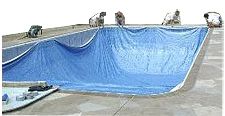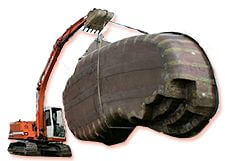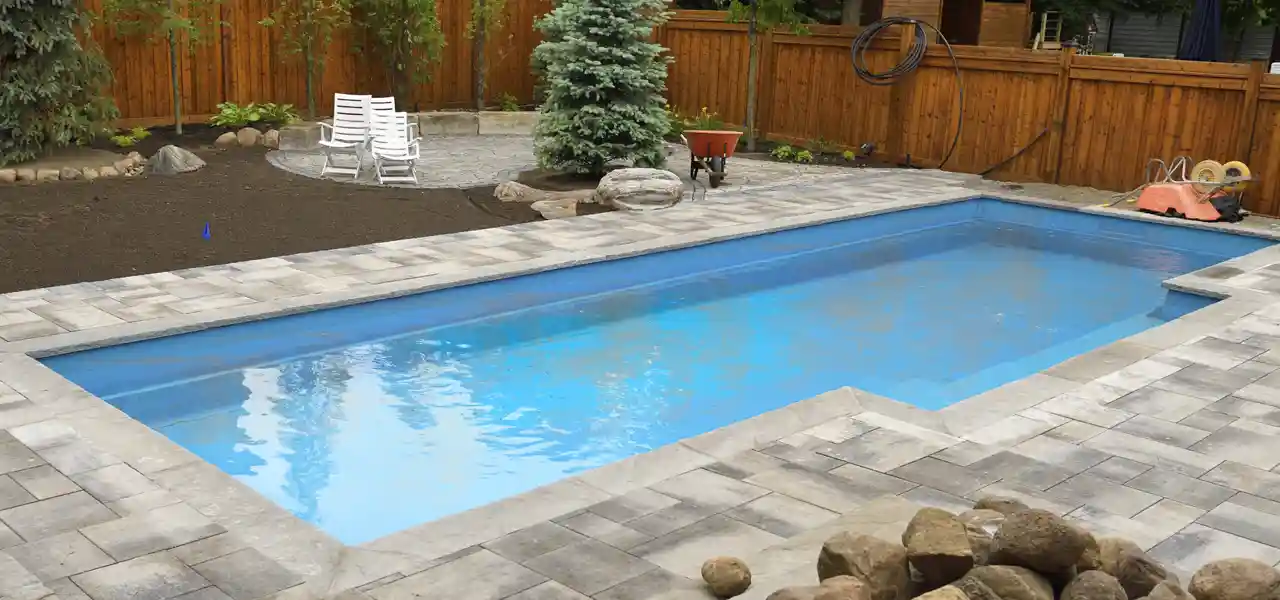
Some people don’t think too much about their pool surface. I suspect these are the same people who don’t notice the dings and scratches on their car’s exterior.
But for those of you who DO notice such things, and want to protect the look and feel of your interior pool surface, this blog post is for you.
Plaster Pool Surfaces
Plaster was introduced in the late 1940’s as a solution to the problem of having to paint the pool every year. It was quickly accepted as a waterproof top coat for gunite or poured concrete pools. Plaster offers a long life, but being a natural product, it does degrade over time. Pool Plaster lifespan ranges from 15-20 years, depending on the care given to it, and your tolerance for staining and surface irregularities.
Plaster Problems:
- Etching. Pits or pock marks can develop from poor water chemistry. These make the surface rough and uncomfortable, and give algae a good surface to attach themselves.
- Staining. Plaster is probably the easiest staining surface of all pool types. Minerals and metals in the water can be the cause, or heavy organic debris can dull and darken a plaster finish.
- Delaminating. Not caused by poor plaster care, but likely the result of poor prep work prior to replastering, or from issues in how the new plaster coat was applied. Not a common problem, so don’t lose any sleep over it!
- Cracking. Also not a big problem. Plaster does not crack on it’s own, unless there are structural problems in the pool shell. Shrink cracks can occur if the pool is plastered in high heat, and not filled rapidly – or from new plaster being exposed to cold air during winter.
Plaster Care:
- Water Balance. Low pH and Alkalinity levels creates a corrosive environment, and low Calcium Hardness levels creates aggressive water conditions that can pull calcium from your plaster. High pH levels can create an opposite effect, and produce scale or calcium crystals on your plaster surfaces.
- Mineral Management. Minerals in the water, such as copper and silver can be used as natural bactericides, but too much of it can stain a plaster surface. Likewise, minerals like iron or manganese, common in well water can deposit themselves on a plaster pool surface quite easily. Use mineral magnets, such as Stain Away to keep them sequestered, in solution, to prevent staining.
- Water level. To prevent cracking and crazing on steps and seats, and to reduce water line staining, keep your plaster covered in water all year around. This is especially important during the first few years of a new plaster coating.
- Brush! Plaster pools need to be brushed daily for a few weeks after a new coat. Afterwards, brushing your plaster will help to keep the surface smooth, by sweeping away very small corrosives that an etch the surface. Brushing also helps prevent algae from gaining a strong foothold in very tiny, dirt filled pockets.
Plaster Replacement:
 Concrete or shotcrete pools are built with steel and are sturdy enough to have 50 year warranty, and can last much longer. Typically, concrete pools are coated with a plaster mix. Concrete pools can also be coated with a surface of aggregate, commonly known as PebbleTec, or have quartz aggregate or pozzolans mixed into the plaster to add color and strength.
Concrete or shotcrete pools are built with steel and are sturdy enough to have 50 year warranty, and can last much longer. Typically, concrete pools are coated with a plaster mix. Concrete pools can also be coated with a surface of aggregate, commonly known as PebbleTec, or have quartz aggregate or pozzolans mixed into the plaster to add color and strength.
Most pool plaster that is well taken care of, in a residential environment, should last 15-20 years before a new plaster coat is needed, but much like a pool liner, many people may re-plaster at 10-15 year intervals, to improve appearance or to go along with other repairs (tile and coping replacement, for instance). Pool plastering is not something that is DIY friendly, and prices for a pool replaster, also called a new whitecoat, start at $5000 for regular plaster on a small to medium sized pool. Optional additives or alternative surfaces can double the cost.
Plaster pools have the unique ability to be acid washed, which strips a thin layer of plaster from the walls and floor, exposing fresh, unstained plaster. Acid washing can remove stains and restore a plaster surface, but eventually, the 1/2″ plaster coating wears thin and will need to be replaced.
Vinyl Pool Surfaces
Vinyl pools were first engineered in the 1950’s, as a quick and economical way to install an inground pool. Beneath the vinyl liner, is a floor of concrete or vermiculite, with walls made of polymers or steel. In ground vinyl liners are available in 20 mil or 28 mil thicknesses, and commonly last 10-15 years before replacement is made necessary from degradation or simply a bright new pattern is desired.
Vinyl Problems:
- Rips & Tears. Common-sense practices will avoid these uncommon problems. Liners can rip from pets or animal claws, pool poles, golf cleats or any sharp object. Liners that are old and overstretched can seem to develop holes on their own, or rocky floors or rusty walls can cause holes in a vinyl liner.
- Fading & Bleaching. Fading from the sun and bleaching from low pH or high chlorine levels, or adding undiluted chlorine shock to the pool can make a liner look old and tired.
- Shrinking. A vinyl liner should be a tight fit, to prevent wrinkles or overstretching. After a liner is installed with a vacuum, the weight of the water holds the liner in place. If too much water is removed (over half), the liner can relax and shrink, especially during cold weather.
Vinyl Care:
- Water Balance. Vinyl liners can literally have the life (plasticizers) sucked out of them by poor water chemistry. Low pH and Alkalinity or high sanitizer levels creates corrosive pool water. Over time, it turns your soft and pliable vinyl into a dry and stiff plastic.
- Borderlines. Vinyl liners are filled with UV inhibitors when new. Over time, a pool in the bright sun may develop fading above the waterline. See our earlier blog post on the stick-on Borderlines, which covers up and renews a faded liner.
- Oil & Scum. You don’t have that in your pool, do you? You may have more than you think. Using an enzyme product such as Pool Magic will consume oils and organics in the pool that can create a nasty bath tub ring around a vinyl pool, in summer or winter.
- No Sharp Stuff. Many vinyl liner holes are made with kids playing with the sharp end of the pool pole, or glass items around the pool. Animals with sharp claws should be kept out of the pool. Fortunately, a vinyl patch kit is an easy way to make a quick repair.
Vinyl Liner Replacement:
 Pool liners are often sold with 20 or 25 year warranties, but most people that I know will replace the liner years before the warranty is up. Sometimes it’s just to change the color or pattern, and other times the liner has become faded or torn after many years of service, usually around ten years.
Pool liners are often sold with 20 or 25 year warranties, but most people that I know will replace the liner years before the warranty is up. Sometimes it’s just to change the color or pattern, and other times the liner has become faded or torn after many years of service, usually around ten years.
Replacing an inground vinyl liner is something we’ve talked about a lot on this blog. You can do it yourself for around $1000, or $1500 if your pool is large. Buying custom inground vinyl liners is something anyone can do, with measurements sent to your In The Swim liner expert. Tools and supplies needed are minimal for installing an inground pool liner as well. However, if you want to have a service company replace an inground pool liner, turnkey prices are around $4000.
The walls of an inground vinyl pool are constructed of steel or polymer, and are good for 50 years, or longer. Individual wall sections can be replaced, if traumatic events would require it, but that is a rare occurrence with modern pool walls. Like concrete pools, you can replace the pool deck without effect to the pool walls.
Fiberglass Pool Surfaces
Another product of the 1950’s idea boom was the one piece fiberglass shell. Early models by some manufacturers had trouble with cobalt spots, air bubbles or low grade finishes. Modern fiberglass shells use more durable gelcoats and resins to prevent many of these surface issues, but problems do still arise. Fiberglass resurfacing is an option for appearance or to correct physical issues, every 20-25 years.
Fiberglass Problems:
- Cracks. Gelcoat is the hard ceramic like coating that covers the strands of fiberglass on the pool interior. Unlike plaster, fiberglass cracks are not caused by drying out or temperature. It’s more often from a stress placed on the walls or floor, usually during transportation or installation. Unsupported or loose fill beneath the floor and behind the wall can also cause gelcoat cracking in a fiberglass pool.
- Fading. The gelcoat has an impregnated color and is UV stabilized, but over time, the color will lighten above the water line. Fiberglass pools can also fade all over, if poor chemical management goes on for too long.
- Staining. High organic load or heavy metals like iron and copper can stain the surface, at the water line or all over, with a ugly brown or greenish stain. Colored fiberglass pools can stain white in cases of very high calcium or salt levels.
Fiberglass Care:
- Water Balance. Noticing a trend? For all surfaces, proper water balance is paramount to keeping your pool looking great. Avoid corrosive, aggressive or scaling water conditions, which can eat away at your surface, or make deposits.
- Mineral Management. Another common care practice for any pool type. Use sequestering agents or chelators to keep minerals tied up in solution. Especially important if you are on a well, or you use copper based algaecide.
- Water Level. You shouldn’t drain a fiberglass pool, or surface appearance may be the least of your problems. Keeping a full pool also avoids bathtub rings. Mesh covers are not recommended if there are any nearby trees.
- Salt Level. If you use a salt system on a colored fiberglass pool, check with the manufacturer of your salt chlorine system for recommended salt levels. If salt levels are too high, colored pools can take on a frosty white tone.
Fiberglass Shell Replacement:
 Fiberglass pools are often sold with 25 or 35 year warranties on the shell, and in most cases, a fiberglass pool shell, typically covered in Gelcoat, similar to a pool slide surface, is a solid structure that will outlast the warranty.
Fiberglass pools are often sold with 25 or 35 year warranties on the shell, and in most cases, a fiberglass pool shell, typically covered in Gelcoat, similar to a pool slide surface, is a solid structure that will outlast the warranty.
In other cases however, especially in situations where the pool is surrounded by expansive soils or high water tables, the supporting soils beneath can shift, which can cause stress cracking or bowing in areas of the pool. Hollow spots under the floor can lead to concave cracking.
For most fiberglass pools, one would be wise to plan on shell replacement or resurfacing after 20-25 years. If the shell is in good shape, with few hollow spots and very little cracking, a local company can rebuild fiberglass pools. Prices for fiberglass resurfacing start at $5000 for small pools. Problem is, not every town in America has a fiberglass pool restoration company. In Florida, and much of the eastern coastal regions it’s no problem – but other parts of the country are not adequately served.
Shell replacement is a expensive option, and one that is usually avoided if possible. The cost of a shell replacement, even just a few years after building the pool, will surely cost more than the price of the original pool, and may involve a new pool deck and new plumbing, so really can be a completely new pool.
So, the lesson for the day is to manage your pool water chemistry, keep your minerals in check, and keep the pool as clean as possible. This will stave off the eventual resurfacing that all pool types will need at some point.
Let us know if you’re having particularly challenging issues with your pool surface – for those of you that notice such things, that is!



This is a great article. I recent learned a great deal about pool surface care. Some of the tricks seemed like pretty good advice. The dental picks are used similarly to the sanding pads for the pool finish. Use the same techniques to verify the condition of the grout.